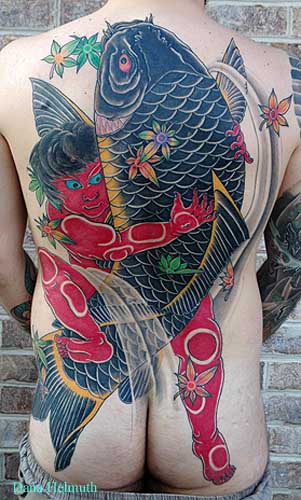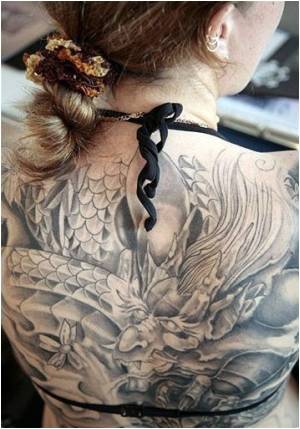|
|
|
|---|
|
|
|
|---|
Beautiful Japanese Tattoos for Girls
more about Japanese Tattoos
Unlike the Chinese people, the Japanese people are currently very big on tattoos, but that was not always the case. In fact, for a brief time near the end of WW II, getting or giving a tattoo in Japan was actually illegal. The end of the war brought an end to that crime as well.
The alphabetic characters that appear in many Japanese tattoos are called Kanji. These characters, alone or in combination with others, can display a whole range of human emotions, thoughts, proverbs and poetry.

In addition to the calligraphic-like Kanji characters, there are many different animal, spiritual and nature-oriented symbols and images that make their way onto people's body parts in the form of a Japanese tattoo.

Traditional Japanese Tattoos
Irezumi, one of the more traditional Japanese tattoo styles depict dragon, koi and other symbols of Japanese culture and lifestyle. These types of Japanese tattoos are becoming increasingly popular with women who are having these sometimes intricate tattoo designs placed on their hips, back, ankles and arms. Even an occasional breast dragon has been spotted in the wild or during a wet T-shirt contest at some spring break bar in Florida or Mexico.

Japanese Dragon Tattoos for men

The popular locations for inking Japanese dragon tattoos.
Japanese dragon tattoos can wrap around the body and flatter the contours of the body, full body and full back dragon tattoos are quite common, and the most popular location is half sleeve, the body of the dragon wrap around the upper arm and the dragon head extend out the upper front, just above the heart. Because of the long shape of the dragon, it also suited for inking on arms and legs.

Girls Sexy Japanese Tattoos
The growing popularity of body art in Russia was laid bare at a Moscow exhibition due to close on Sunday, at which the options ranged from tattooing to tongue splitting and mid-air suspension from hooks embedded under the skin.
"People are trying to become individuals," explained Olesya Crow, a local tattoo artist -- she uses only her commercial name -- among dozens of exhibitors at the Moscow International Body Art Festival.
"Society has become more tolerant and has developed. Tattoos are now a branch of art."
The setting of the festival, in an exhibition centre built to display Soviet agricultural and scientific prowess and dominated by a statue of Soviet leader Vladimir Lenin, might have appeared incongruous.
But Crow, who also takes part in human suspension, in which metal hooks are fixed under the skin of a person's chest, back or legs prior to hoisting them into the air, sometimes for hours, said her work represented social progress.
"Tattoos are now seen as something beautiful, an adornment of the body," as opposed to the stigma they carried in Soviet times, when they were associated with prisoners and crime, she said.
As for human suspensions, which Crow supervises, having undertaken four years of medical training, they "can have a healing effect, give a spiritual lift."
Religius Tattoo Tips
• Does it have meaning for you?
• Will it offend someone else's beliefs?
• Are you aware of its history and true meaning?
• Are you prepared to become identified with a certain group by virtue of your tattoo?
• Are you prepared to defend your choice?
























